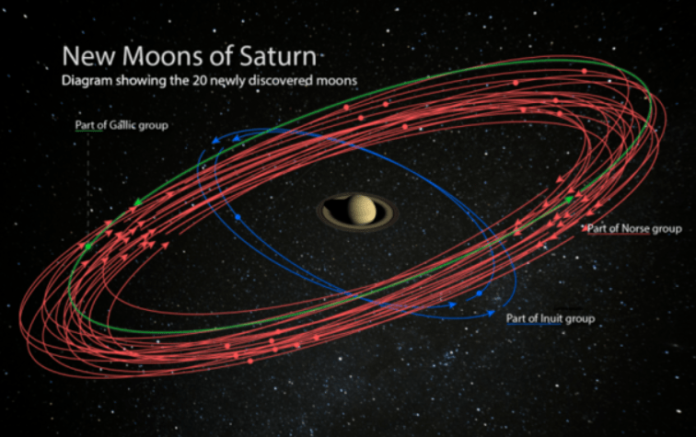Astronomers have discovered 20 new satellites of Saturn, making this gas giant a champion in the solar system in the number of known satellites (previously it was Jupiter). Anyone can offer names for new objects, the satellites themselves should be named after giants from Scandinavian, Gallic or Inuit mythology.
Until recently, Jupiter was the champion in the number of known satellites in the solar system – it has 79 satellites open. The second place was occupied by Saturn with 62 satellites, followed by the ice giants Uranus (27), Neptune (14) and the dwarf planet Pluto (5). A little more than ten bodies of the Solar System possess two satellites, and one – more than a hundred objects.
On October 7, 2019, a group of astronomers led by Scott S. Sheppard reported the discovery of 20 new satellites orbiting Saturn, which increases their total number to 82, thereby making Saturn the record holder for the number of satellites. The observations were carried out using the ground-based 8-meter telescope “Subaru”. The diameter of each of the newly discovered satellites does not exceed five kilometers, seventeen of them have a retrograde character of orbital motion (the direction of motion does not coincide with the direction of rotation of Saturn), and three more move in the prograd direction.
The period of revolution of satellites around the gas giant is from two to more than three years, and one of the retrograde satellites was recognized as the farthest known satellite of Saturn. Two new satellites fit into the group of external satellites, with inclinations of about 46 degrees, called the Inuit group. It is assumed that these bodies can be fragments of the large satellite of Saturn that has collapsed in the past. Newly discovered retrograde satellites from the Norwegian group can have the same origin. Another satellite has an orbital inclination of about 36 degrees and resembles a group of Saturn’s internal satellites, called the Gallic.
Following the announcement of the discovery, the Carnegie Institute launched a contest for the best names for newfound satellites, in which anyone can participate. The competition will last until December 6, 2019, its rules are published in the public domain. The satellites should be named after giants from Scandinavian, Gallic or Inuit mythology, depending on which group they belong to.
Via | The Carnegie Institute
